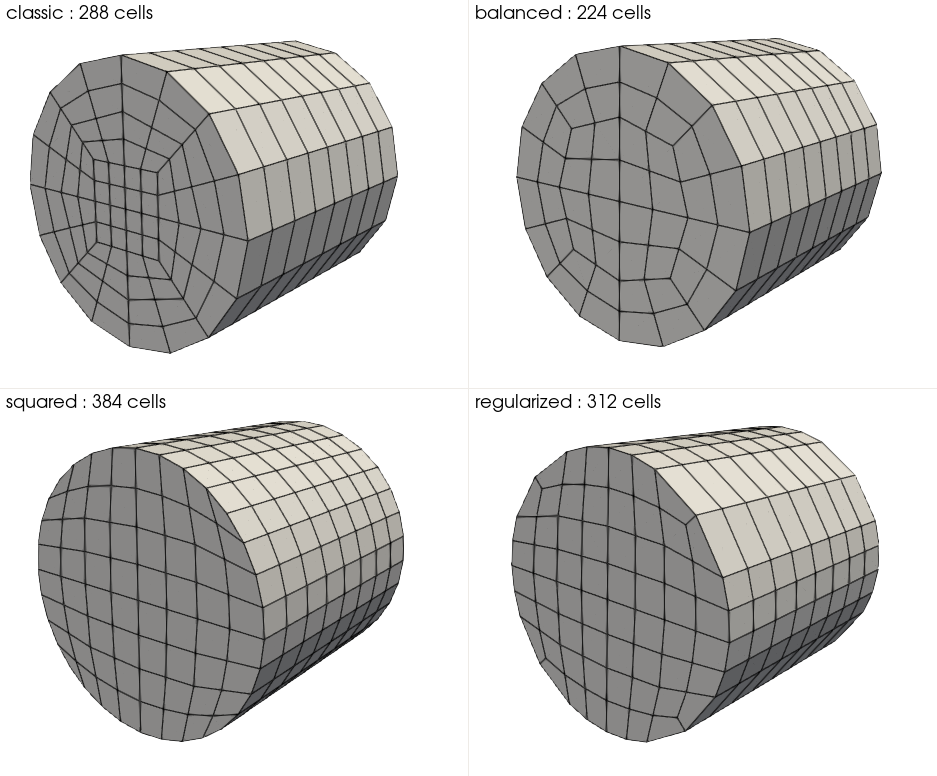Mesh#
This subsection provides information of the simulation geometry and its mesh. The simulation geometry shape and size, number of refinements and other required information can be provided here. It should be mentioned that meshes from gmsh can also be defined in this section by setting type = gmsh.
subsection mesh
# Type of mesh. Choices are <gmsh|dealii|cylinder|periodic_hills>
set type = dealii
# GMSH file name
set file name = none
# Grid arguments for dealii, cylinder and periodic_hills
set grid type = hyper_cube
set grid arguments = -1 : 1 : false
# Initial refinement of the mesh
set initial refinement = 0
# Initial refinement of the mesh near user-specified boundaries
set initial boundary refinement = 0
# List of boundaries next to which the mesh should be refined. The list must contain integers separated by commas.
set boundaries refined = 0, 1
# Enable initial refinement until target size is reached
set enable target size = false
set target size = 1
# Indicates that the mesh is a simplex mesh
set simplex = false
# DEM-specific mesh parameters
# Enables checking the input grid for diamond-shaped cells
set check diamond cells = false
# Enables adding the boundary neighbor cells of boundary cells to the particle-wall contact search list
set expand particle-wall contact search = false
# Mesh modification parameters
# Translation to apply to the mesh
set initial translation = 0, 0, 0
# Rotation to apply to the mesh
set initial rotation axis = 1, 0, 0
set initial rotation angle = 0
# Mesh scaling factor
set scale = 1
end
- The following choices for the mesh type are available:
gmsh: if this type is chosen, a.mshfile generated from GMSH can be used. In this case, the grid file name must be specified in thefile namevariable.dealii: if this type is chosen, the deal.II grid generator class can be used. For additional documentation on these grids, you can consult the deal.II documentation for the GridGenerator . The type of grid is specified by thegrid typeparameter and the arguments used for grid generation by thegrid argumentsparameter.periodic_hills: if this type is chosen a mesh for the periodic hills CFD benchmark is created. For more details on this type of mesh and its grid arguments refer to Flow over Periodic Hills.cylinder: if this type is chosen, thegrid typemust be chosen according to the following figure. Theclassictype is equivalent to a subdivided cylinder from deal.II andgrid argumentsmust follow their related deal.II documentation for a cylinder and this applies to all cylinder grid types.
Warning
The squared cylinder may eventually leads to ill-posed jacobian transformation. As said in the deal.II documentation : “The four cells that were originally the corners of a square will give you some troubles during computations, as the jacobian of the transformation from the reference cell to those cells will go to zero, affecting the error constants of the finite element estimates”. This type of mesh is available, but its usage is not recommended.

The initial refinement number determines the number of refinements the grid will undergo in the simulation before the simulation is run. This allows one to refine a coarse grid automatically. By default, most deal.II grids will be as coarse as possible and need to be refined. This is a desirable behavior for parallel simulations, since for quad/hex meshes, the coarsest level of the grid is shared amongst all cores. Consequently, using a coarse grid with too many cells will lead to a prohibitive memory consumption.
The initial boundary refinement determines the number of refinements the grid will undergo in the simulation in the vicinities of the boundary specified by the
boundaries refinedparameter.The enable target size and target size respectively enable and provide a maximal target size that initial refinement cycles must lead towards, in contrast to the more common way of specifying the number of refinement cycles to apply.
The check diamond cells and expand particle-wall contact search are parameters used in particles simulations. The former is used to verify the quality of the background mesh; detecting diamond cells is important as they should be avoided. The latter serves a purpose in contact detection when the background mesh is concave.
simplex. If simplex is set to true, it indicates that the mesh being read is made of only simplex elements. If the mesh is of
type = dealiiit will be converted from a quad/hex mesh to a simplex mesh. If the mesh is oftype = gsmh, it will be read from a file as long as it is only made of simplices.The initial translation parameter provides a way to move the mesh in space prior to simulating the problem. It can be useful when space-dependent functions are used, but that generating a translated mesh is inconvenient or impossible.
The initial rotation axis and initial rotation angle parameters provide another way to move the mesh prior to simulating the problem.
The scale parameter is used to scale the mesh. This is useful when the mesh is made in a different set of unit than what is desired by the simulation.
Warning
When scale, translation and rotation are used together, the scaling is applied first, then the rotation, then the translation.